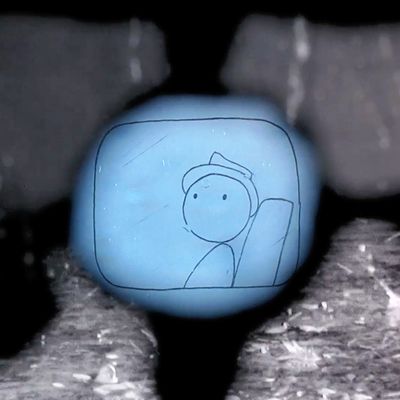
As the spread of coronavirus continues to halt the release of new movies in theaters, Vulture’s film critics will be sporadically reconsidering the movies available to stream from home instead.
Late last week, independent animator Don Hertzfeldt announced that his 2011 feature, It’s Such a Beautiful Day, could now be rented for free on Vimeo. This will hopefully encourage a broader audience to discover this most sublime of pictures, which ranked No. 12 on our recent list of the best movies of the past decade. At the same time, it feels odd to recommend It’s Such a Beautiful Day during a period of pandemic and death, for it is one of the saddest films I’ve ever seen: It’s essentially about a young man losing his mind, made in a style that mimics the surreal, unruly turns of his consciousness.
Recommend it I will, however — and heartily, too — because there are almost unbearable levels of artistry and invention in this movie. Hertzfeldt’s attention to the fleeting glories of existence makes you feel one with the universe; in 62 quick minutes, his simple, trembling line drawings convey the uniqueness of our lives and our interconnectedness as thinking, loving, hurting beings. Yes, it might be shattering, but rewatching it made me feel more alive and hopeful than I have in weeks.
The film follows a man named Bill — a basic, black and white stick figure, just like everyone else in the movie, only he has a hat — as he goes about his days, with a growing sense of disquiet hanging over his world. Words come out wrong when he tries to greet someone. He’s suddenly perturbed by meaningless interactions and sights at the grocery store, on the street, on the bus. He begins to wonder if his life consists entirely of meaningless rituals and routines. He calls his ex-girlfriend and has an awkward exchange with her. He gets a visit from his doting mom and has an irrational, violent reaction to her.
This isn’t just existential malaise, however. Bill knows something is wrong. His unease waxes and wanes. Shock gives way to boredom. His mind catastrophizes, then quiets. Days and moments blend into one another. His thoughts loop back and forward, then drift into random byways, as the film mimics the everything-happening-at-once disorientation of his mind. The images onscreen vary from simple animations to split screens to collages of home movies, nature photos, and random experimental footage, occasionally swelling to orchestral crescendos. (Literally. The score includes selections from the likes of Schumann, Smetana, and Wagner, and if at times the film reminds you of a more compact version of Terrence Malick’s The Tree of Life — another movie to watch in these troubled times — that might be in part because the two titles share some needle-drops.)
Meanwhile, Hertzfeldt breathlessly narrates Bill’s thoughts in the third person, his voice filled with equal parts anxiety and bemusement, his ornate sentences jumping from the transcendent to the clinical to the ridiculous until you realize that those are all the same thing. Example: “He began to think of people in a new light, how everyone is just little more than that frightened, fragile brain stem surrounded by meat and physics, too terrified to recognize the sum of their parts, insulated in the shells of their skulls in lower-middle-class houses, afraid of change, afraid of decision, afraid of pain, stuck in traffic, listening to terrible music.”
The film drifts to memories of Bill’s family and beyond — to the disabled young brother who ran into the sea one day in pursuit of the sun and disappeared, to an ancestor who was a “preacher who grew his mole hairs long to purify his soul,” to a forgotten, unwanted child a century ago who was fed carbolic acid and ate mud and sticks and came back to wreak havoc on the family that abandoned him. (“He died alone in a field one summer morning while dreaming of the moon,” Hertzfeldt narrates. “Six weeks later, a sunflower grew out of his head.”)
Such absurdism is never hip or ironic or cute, however. (This film is the opposite of twee; any given minute of it seems to be of cosmic import.) In Hertzfeldt’s vision, each of these random family members and ancestors, right down to Bill himself, feels just another of the many billions of souls that have passed through this life. That is ultimately what It’s Such a Beautiful Day is about — about recognizing the good around us, the wonder of our lives, the marvelous beauty of everything from a beach to a brick wall. In the film’s most heartbreaking, and hilarious, moment near the end, Bill wanders the streets — or at least thinks he does — his thoughts exploding in all directions, his mind suddenly agonizingly alive to every little detail around him.
“He walks down his side street and sees striking colors in the faces of the people around him, details in these beautiful brick walls, and weeds that he must have passed every day and never noticed,” Hertzfeldt intones. “The world is clumsy, and beautiful, and new. And it’s as though he’s been sleepwalking for God knows how long. Something has violently shaken him awake … His bathmats are gorgeous.”


